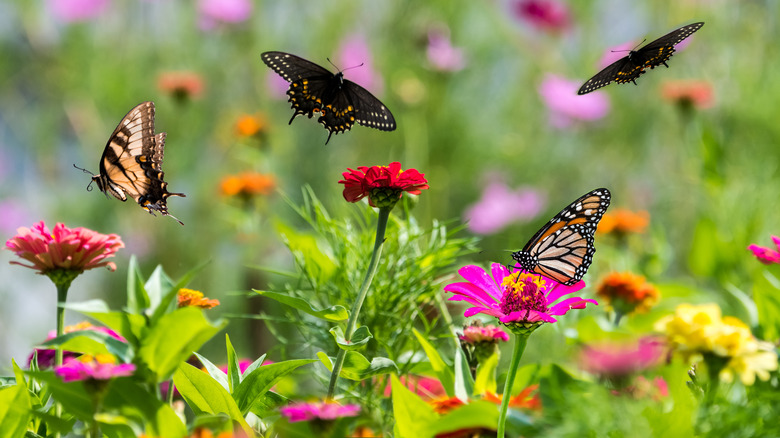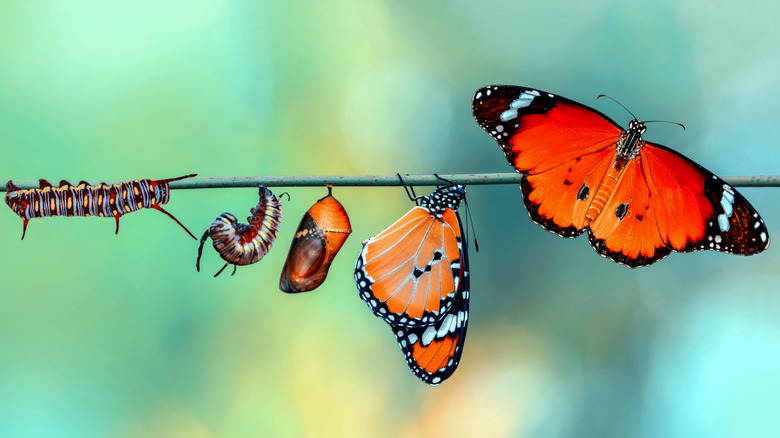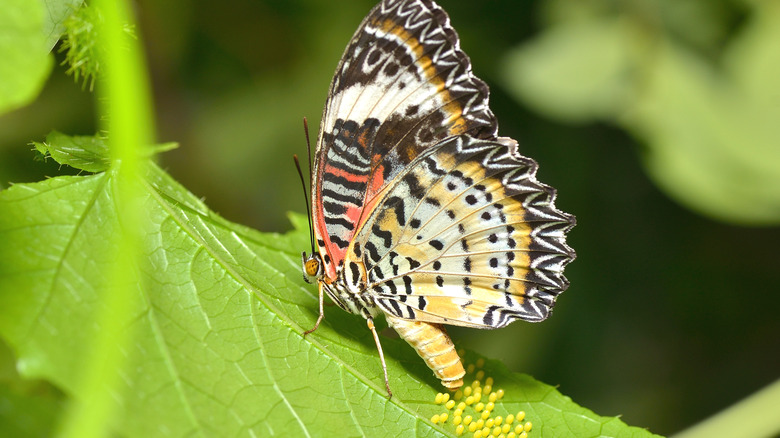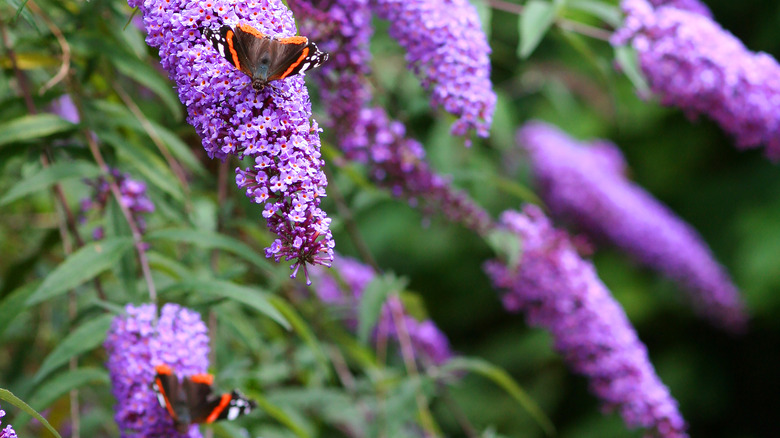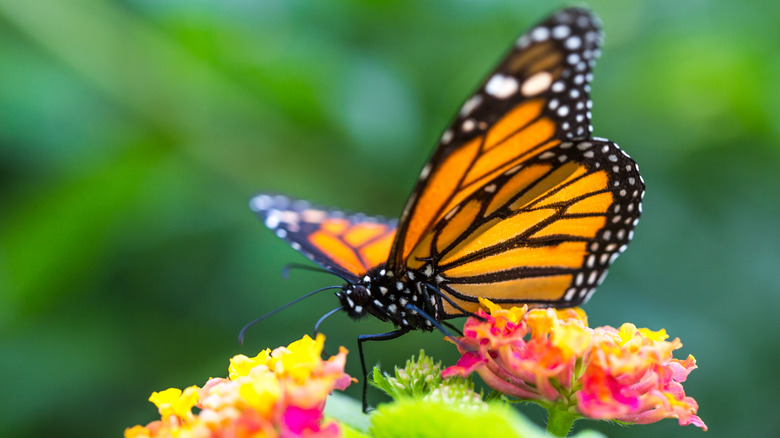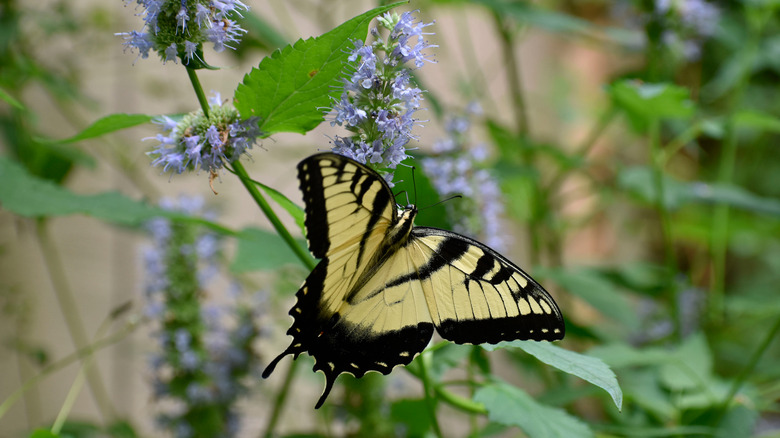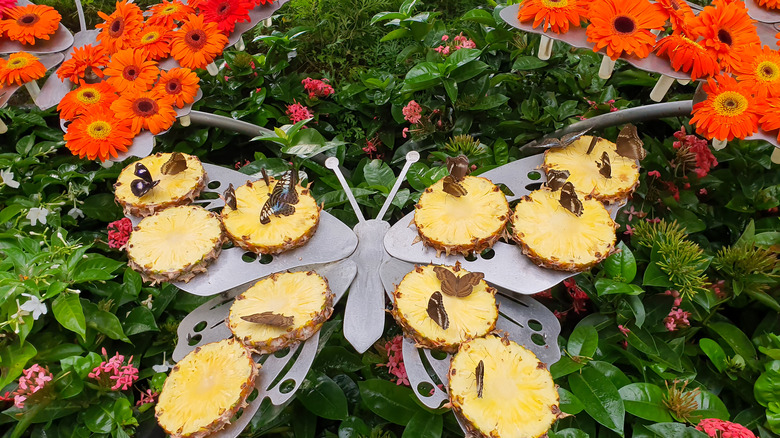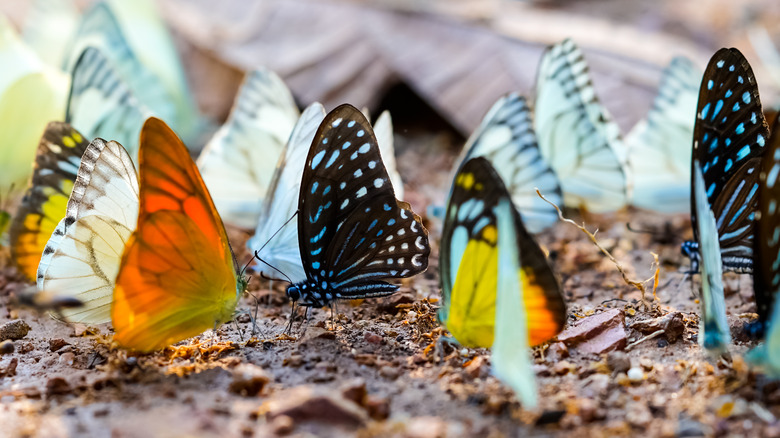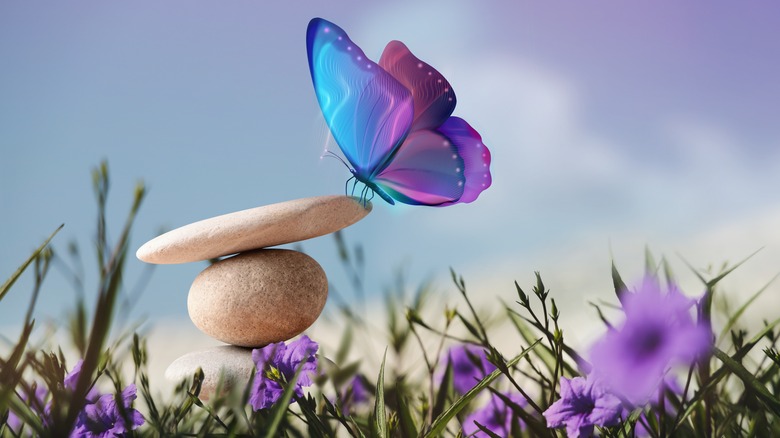How To Attract Butterflies To Your Garden
One of the sweetest, most heart-tickling sights to behold is a small child chasing a butterfly. They giggle and squeal as they run across a yard, displaying a mixture of unfettered delight, open-eyed wonder, hopefulness for a successful catch, and steely determination. Butterfly chasers are enough to make you believe all things are possible in a topsy-turvy world.
If you want to see butterflies (and possibly the small children in your life) flutter about on warm summer days, you'll need to give them a reason to visit. Attracting butterflies to your garden is a relatively easy task. With some planning and patience, you'll be happily zigzagging with the flying flowers around your yard with all the glee of a toddler.
Since butterflies are pollinators, the first consideration is to incorporate plants that give butterflies something to do; in other words, be sure your garden has plenty of plants that require the butterfly's pollinating services. Don't stop there, however. Be sure to meet the needs of the insects across their lifespans, beginning by providing hospitable environments for egg laying, food for larvae, locales for the chrysalides, and nectar for the adult butterflies. In addition, butterflies need more than food, per the University of Kentucky. Read on for detailed tips on attracting butterflies to your garden.
Attracting butterflies throughout their life stages
At the top of the list when attracting butterflies is to grow plants that the insects want. A butterfly's diet varies by species and changes throughout its lifecycle, so if your goal is to create a haven for them, you'll need to provide hospitality to the butterflies throughout their lifespans — each of which is described by the American Museum of Natural History. Humans can't offer any sustenance at the first stage of life, which is when the butterfly is just an egg, nor when the pupa (third stage of life) is in its chrysalis. However, they can at the larva stage and the final butterfly stage.
Plant matter is a top choice for most butterfly larvae, but individual species each have their preferences, says the Nebraska Extension in Lancaster County. In general, the picky eaters love munching on leaves and flowers, but USA Tales is quick to point out that there are other favored food sources. One unexpected food source, says Feeding Nature, is honeycomb, so if you have bees setting up domiciles nearby, you are likely to find butterflies, too. USA Tales also notes that some types of butterflies are fond of grasses, fibers, animal carcasses, and red ants.
Making room for baby butterflies
There can't be butterflies unless there is first a place to lay eggs that become the sought-after flutterers. Green Bay Botanical Garden shares that the many butterfly species have different egg-laying preferences. Eggs are laid on plants that then become a food source for the emerging larvae with their voracious appetites.
In addition to choosing egg-laying locales that become caterpillar food, the North American Butterfly Association answered the question of where butterflies lay eggs by sharing that the eggs are found on various parts of a plant. Some butterflies prefer laying eggs on top of leaves, others on the undersides, and eggs can even be found on stems or stalks of plants.
With tens of thousands of butterfly species, it isn't difficult to find a favorite, and creating the right environment for egg-laying is a good start. For example, if you are eager to see more Eastern tailed blue butterflies, says the University of Missouri in their Garden Adventure series, create spots in your garden where clover can take over and wild pea vines can climb.
Blooms for butterflies
From bright fuchsias to vibrant oranges to sunshine yellows, the flowers that attract butterflies are plentiful. Plant a garden that teems with color if you want to invite visitors from the Lepidoptera family, which has over 180,000 species, according to PBS's Wildlife Journal.
The butterfly bush is aptly named and can often be seen with a multitude of butterflies dancing around it. Butterflies are attracted to the bush's nectar-rich purple and white flowers. The University of Maryland cautions, however, that the plants can be invasive and have seeds that spread by wind and water making it difficult to contain them. They offer several other butterfly-attracting options, such as butterfly weed and Virginia sweetspire. If those plants don't work for you, Almanac has a large list of flowers and flowering bushes (many of them perennials) to help gardeners determine the color, style, and growing habit that works best for their location and preferences.
Milkweed for monarchs
Monarch butterflies are a favorite flying visitor for Lepidoptera lovers, and most people are aware of its penchant for milkweed. If it's a monarch butterfly you're seeking, you will need to find space in your yard to cultivate milkweed. Why? Because much like a toddler who insists on eating one particular cereal every single day, milkweed is the only food source for monarch larvae. Offering this plant for monarch butterflies couldn't be more important in light of their decline, which, according to American Meadows, has seen a 90% drop in just 20 years!
Save Our Monarchs says it's easy to grow milkweed, beginning with knowing the microclimate in your area so that you can select the variety that grows best where you live. They recommend giving the seeds a boost before planting by putting them in damp paper towels before stashing them in the refrigerator for a month. Just be aware that milkweed sap is an irritant and the plant in general is toxic. Once planted (using gardening gloves, of course), it's wise to steer clear and leave them for the monarch butterflies.
Fragrant gardens for flying friends
As you map out a garden with plants that are alluring for butterflies, consider more than just the color of the plant or the type of plant — give thought to the scent the plant produces. According to Gardens with Wings, the chemoreceptors on the butterfly's body allow it to smell when there is nectar nearby. The scents cause the same reaction in butterflies (hunger and excitement) that humans get from smelling their favorite food like homemade brownies at Grandma's house.
Birds and Blooms also notes that butterflies are attracted to scents in addition to color, and gardeners can maximize their enjoyment with a little planning. By planting mint, for example, they say you can have a very useful herb that smells wonderful and entices the delightful winged visitors you seek. (And where there is mint, there should be mojitos. Mashed has you covered with both classic mojito versions and non-alcoholic ones.)
Attracting butterflies throughout the growing season
Whether your growing season is long, like in Florida or Hawaii, or as short as an Alaskan summer, you'll want to make sure you are cultivating plants that provide for butterflies' needs throughout the growing season. Blooms that extend through long periods of time can make it easier on the gardener. Plant some long-blooming coreopsis or Russian sage, says Birds and Blooms. The stunning dahlias and daisy-like cosmos are other good choices for attracting butterflies.
When it comes to creating a butterfly-friendly oasis, there are many varieties, colors, flower shapes, and plant heights to fill your garden. Even late in the growing season, there are plants that can support the needs of butterflies. The Natural History Museum in the U.K. mentions that ivy offers nectar in autumn months. They add that leaving fruit on the ground or a compost heap, if you have one, can provide for late summer nectar needs.
Refreshing liquids for butterflies
When attracting butterflies to your yard, the most obvious way to do it is to provide the flowers they love. Butterflies do need nectar or substances that imitate the sweet fluid. They also need minerals that come from water sources. Gardeners often attract hummingbirds by filling a hummingbird feeder with a weak sugar solution. Butterflies enjoy sugar water, too. Butterfly Fun Facts recommends solutions that include a ratio of 15-to-1 water to sugar or honey. They also note that fruit juice or Gatorade can be good options for attracting butterflies.
Bird baths are a common garden addition, but gardeners aren't always aware that butterflies like to take a dip now and then, too, though their water needs are different. Puddling -– soaking up minerals and salts in a muddy area –- is important to butterfly health, especially for male butterflies, says the journal Animal Behavior. Use a shallow dish and add some organic soil, sand, and/or compost to a slightly wet consistency. Toss in a few large stones for butterflies to rest on and place it in a sunny location.
Other ways to encourage butterfly visits
Butterflies don't have long lifespans, so while they are here, give them a hand by supplying them with their needs. The flitting flyers are cold-blooded, so it's important to have warm spots for them, says the University of Kentucky; they add that butterflies aren't able to take flight if they are cold. In general, most of the flowering plants that attract butterflies are sun-worshippers, so your garden is likely to be in a sunny spot so that it can thrive.
To increase its appeal for butterflies, add decorative rocks to your landscape where the insects can bask in the sunshine. Furthermore, butterflies sometimes need shelter. At night, during inclement weather, or when escaping predators, it helps to have a garden where butterflies can escape. The North American Butterfly Association notes that shelter will usually come from trees or shrubs, but you can help by placing the shelters near the food sources. Avoid using butterfly houses or butterfly boxes (they look like tall, narrow birdhouses with narrow slits). According to Backyard Ecology, the evidence suggests that not only do butterflies not use the houses, but that predators like paper wasps do, which can result in the opposite effect to the one you're seeking.
